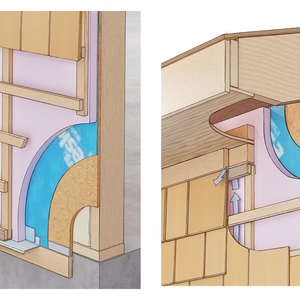I am helping my father install a 17kw standby generator with a pre-wired transfer switch in a flood-prone area. We have previously installed a new 150 amp service repairing the latest flood damage (properly permitted and inspected). All the transfer switch wiring connections are logical and well described with the exception of using GFCI breakers. I have been told there are problems with using GFCI breakers due to the different ways the neutrals within the service panel and the transfer switch are managed.
Should we utilize standard breakers and install GFCI receptacles in the appropriate locations?
BTW all equipment including the generator are mounted well above the flood zone.



















Replies
Is it a whole-house transfer switch, transferring the entire breaker panel to the generator, or the sort that only transfers 4-8 circuits?
In any event, I can't (based on my electrical engineering background and my understanding of how a GFCI breaker works) see how it should make any difference to the breaker whether it's running on utility power or generator power. You just have to make sure that the neutral connection for the particular circuit is routed through the GFCI, along with the hot, just like you'd do normally.
I put in the same type of generator setup a few years ago and don't see why it should matter. To avoid being stuck with a pile of GFCI breakers you can't use, you might buy just one at first to try. I have GFCI everywhere but do it by routing each circuit through a GFCI outlet on the way to the regular outlets. I think it is cheaper and know you end up with a neater service panel.On your generator, if it is a Generac, be very careful to EXACTLY follow the gas piping size and route requirements (e.g., direct run from meter/propane tank to generator with everything else piped separately. If you have any problems with the generator (I did), Generac will not even talk to the service people or consider it a warranty issue unless the piping is exactly as they require.
This a partial service switch (16 circuits), NOT a whole house transfer.I was advised by one person in this area that the inspector would not approve GFCI breakers on his installation because of some issue with the neutrals, but I don't know all the specs for his system.Logically, it would seem the systems would work the same, but on the generator, the neutral IS grounded (no other way to handle it), while utility power has a separate ground and neutral.
Well, first off, a ground isn't necessary for a GFCI to work. So grounds shouldn't be an issue.I can see that you should not use GFCIs for the actual transfer breakers in this panel. In general the way these panels work is that the panel has, say, 8 breakers. Two of them have an interlock so that only one can be on at a time. The utility power is "backfed" through one while the genset is "backfed" through the other. Those two should not be GFCI.But there should be no such issue with the other breakers that are used to feed your individual circuits.If you had a very primitive transfer panel where every circuit had two interlocking breakers (one off the utility bus, and one off the genset bus), then you wouldn't be able to use GFCIs because there would be, in effect, a shared neutral. But I've never seen a transfer panel built this way.Of course, when an inspector has a bug up his arse about some particular issue it can be hard to change his mind.
The modern conservative is engaged in one of man's oldest exercises in moral philosophy; that is, the search for a superior moral justification for selfishness. -John Kenneth Galbraith
Of course, his position would make it hard for you to meet the new AFCI rules (AFCIs on every bedroom circuit or some such), since an AFCI contains a GFCI.
The modern conservative is engaged in one of man's oldest exercises in moral philosophy; that is, the search for a superior moral justification for selfishness. -John Kenneth Galbraith
"Logically, it would seem the systems would work the same, but on the generator, the neutral IS grounded (no other way to handle it), while utility power has a separate ground and neutral."First of all the utility does not have a separate ground and neutral.At the transformer the high tension neutral (if there is a separate one) along with the center tap on the voltage side of the transformer, the neutral lead to the house and a ground wire.But 2 the house only 3 conductors are run, 2 hots and a neutral.At the house service entrance and ONLY at the house service entrance the neutral is bonded to the grounding electrode system (typically cold water pipe and ground rods). Then everything feed off that point the equipment grounding conductor ("the ground") and the neutral are kept isolated.And that is typically how standby generators are connected. 4 wire with a separate ground and neutral connections.Some generators are designed for either standalone service (what is called a separately derived system) or standby service and they have a jumper or strap or lug that can unbond them.I have heard of people rewiring generators that don't have that.The other option is to use a transfer switch that also switches the neutral..
William the Geezer, the sequel to Billy the Kid - Shoe
Own policy is to alway put the GFCI as far toward the end of string as needed, which means outlets vs. breakers.
Hate nuisance trips.
Don't know if this is relevant.
Two weeks ago, started a tile job on Tuesday morning. We positioned the wet saw, filled the water tray, plugged the saw into a 20A, non-GFCI protected outlet. Tested the saw and pump - all working fine.
This was a rented MK saw with a GFCI incorporated into the plug.
We were in the process of setting up some work lights when the house lost power from the POCO.
No big problem, we said as we retrieved and started a 5500 watt Honda generator and ran the saw and light cords to the generator.
Lights worked great, other power tools worked great.
GFCI in wet saw line would trip as soon as we turned on the saw. Generator would load for an instant - GFCI would blow - generator would cycle back to idle.
POCO got power back to the house (whole block actually) after about an hour - wet saw with GFCI functioned perfectly when plugged into a regular outlet.
I wrote it off to GFCI not liking something about the power supplied by the generator.
Jim
Did you ground the generator... as in electrically connected to a stake in the ground?
If not, that is likely the source of the GFCI issues on the generator. Generators have a grounding lug somewhere on the chassis, but I have never seen anyone actually ground a generator.
Could also be something wrong with the generator.
Just educated guesses as I am not an electrician.
"Did you ground the generator... as in electrically connected to a stake in the ground?If not, that is likely the source of the GFCI issues on the generator. Generators have a grounding lug somewhere on the chassis, but I have never seen anyone actually ground a generator."Shouldn't have any affect on a GFCI..
William the Geezer, the sequel to Billy the Kid - Shoe
"Noisy" power can cause false trips on a GFCI, but I wouldn't expect that the genset was that noisy.
The modern conservative is engaged in one of man's oldest exercises in moral philosophy; that is, the search for a superior moral justification for selfishness. -John Kenneth Galbraith
Those types of cords will usually trip every time you unplug them from a wall outlet. I'm thinking that the voltage drop was so much on saw startup with the generator, that it had the same effect.
Did you try running it off of the generator with nothing else plugged in to the generator?
Yeah, that's a thought. The GFCI cords are designed to reset when they lose power. (Why, I don't know -- it leads to a lot of needless looking for the disconnected plug.) If the voltage of the genset drops low enough it could drop below the threshold voltage of the cord and cause it to trip.(In fact, maybe that's why they trip when unplugged -- to detect an overloaded cord.)
The modern conservative is engaged in one of man's oldest exercises in moral philosophy; that is, the search for a superior moral justification for selfishness. -John Kenneth Galbraith
Great minds think alike!
"This was a rented MK saw with a GFCI incorporated into the plug."Those aren't GFCI's. That is they don't have the same design and characteristics as GFCI receptacle or breaker.If have used a power washer with one on it. IIRC (and I might not) it requires reseting after you plug it in.If this one is like that it means that needs power to reset and will trip out without power.My guess is that there is enough voltage drop, when the load is applied, for it to drop out.BTW, modern GFCI receptacles require power to reset, but they don't trip without power unless you push the test button. That is part of new requirements for end of life and to keep them from being installed backwards..
William the Geezer, the sequel to Billy the Kid - Shoe